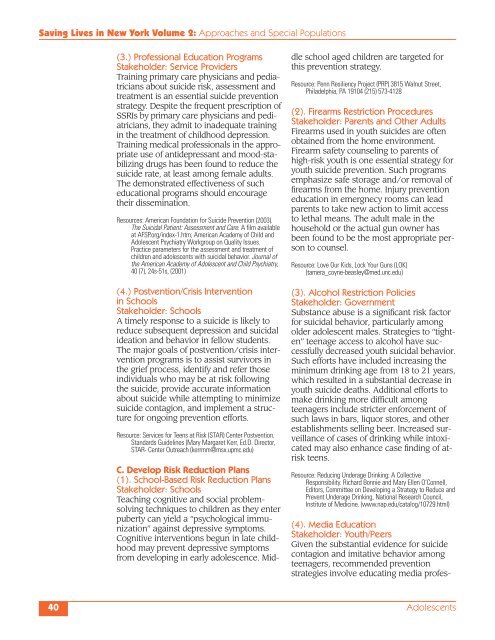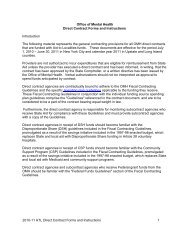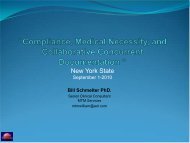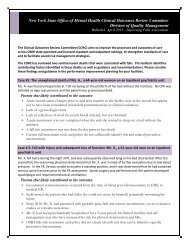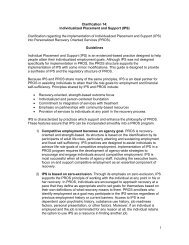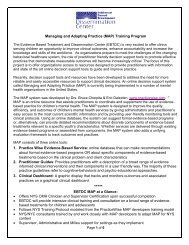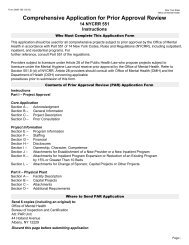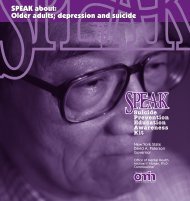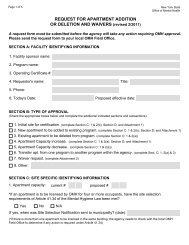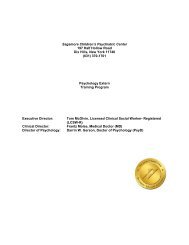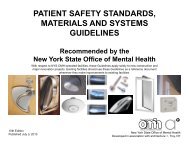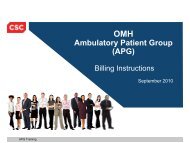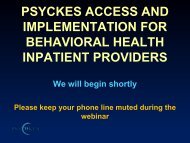Download - New York State Office of Mental Health
Download - New York State Office of Mental Health
Download - New York State Office of Mental Health
You also want an ePaper? Increase the reach of your titles
YUMPU automatically turns print PDFs into web optimized ePapers that Google loves.
Saving Lives in <strong>New</strong> <strong>York</strong> Volume 2: Approaches and Special Populations<br />
(3.) Pr<strong>of</strong>essional Education Programs<br />
Stakeholder: Service Providers<br />
Training primary care physicians and pediatricians<br />
about suicide risk, assessment and<br />
treatment is an essential suicide prevention<br />
strategy. Despite the frequent prescription <strong>of</strong><br />
SSRIs by primary care physicians and pediatricians,<br />
they admit to inadequate training<br />
in the treatment <strong>of</strong> childhood depression.<br />
Training medical pr<strong>of</strong>essionals in the appropriate<br />
use <strong>of</strong> antidepressant and mood-stabilizing<br />
drugs has been found to reduce the<br />
suicide rate, at least among female adults.<br />
The demonstrated effectiveness <strong>of</strong> such<br />
educational programs should encourage<br />
their dissemination.<br />
Resources: American Foundation for Suicide Prevention (2003).<br />
The Suicidal Patient: Assessment and Care. A film available<br />
at AFSP.org/index-1.htm; American Academy <strong>of</strong> Child and<br />
Adolescent Psychiatry Workgroup on Quality Issues.<br />
Practice parameters for the assessment and treatment <strong>of</strong><br />
children and adolescents with suicidal behavior. Journal <strong>of</strong><br />
the American Academy <strong>of</strong> Adolescent and Child Psychiatry,<br />
40 (7), 24s-51s, (2001)<br />
(4.) Postvention/Crisis Intervention<br />
in Schools<br />
Stakeholder: Schools<br />
A timely response to a suicide is likely to<br />
reduce subsequent depression and suicidal<br />
ideation and behavior in fellow students.<br />
The major goals <strong>of</strong> postvention/crisis intervention<br />
programs is to assist survivors in<br />
the grief process, identify and refer those<br />
individuals who may be at risk following<br />
the suicide, provide accurate information<br />
about suicide while attempting to minimize<br />
suicide contagion, and implement a structure<br />
for ongoing prevention efforts.<br />
Resource: Services for Teens at Risk (STAR) Center Postvention.<br />
Standards Guidelines (Mary Margaret Kerr, Ed.D. Director,<br />
STAR- Center Outreach (kerrmm@msx.upmc.edu)<br />
C. Develop Risk Reduction Plans<br />
(1). School-Based Risk Reduction Plans<br />
Stakeholder: Schools<br />
Teaching cognitive and social problemsolving<br />
techniques to children as they enter<br />
puberty can yield a “psychological immunization”<br />
against depressive symptoms.<br />
Cognitive interventions begun in late childhood<br />
may prevent depressive symptoms<br />
from developing in early adolescence. Middle<br />
school aged children are targeted for<br />
this prevention strategy.<br />
Resource: Penn Resiliency Project (PRP) 3815 Walnut Street,<br />
Philadelphia, PA 19104 (215) 573-4128<br />
(2). Firearms Restriction Procedures<br />
Stakeholder: Parents and Other Adults<br />
Firearms used in youth suicides are <strong>of</strong>ten<br />
obtained from the home environment.<br />
Firearm safety counseling to parents <strong>of</strong><br />
high-risk youth is one essential strategy for<br />
youth suicide prevention. Such programs<br />
emphasize safe storage and/or removal <strong>of</strong><br />
firearms from the home. Injury prevention<br />
education in emergnecy rooms can lead<br />
parents to take new action to limit access<br />
to lethal means. The adult male in the<br />
household or the actual gun owner has<br />
been found to be the most appropriate person<br />
to counsel.<br />
Resource: Love Our Kids, Lock Your Guns (LOK)<br />
(tamera_coyne-beasley@med.unc.edu)<br />
(3). Alcohol Restriction Policies<br />
Stakeholder: Government<br />
Substance abuse is a significant risk factor<br />
for suicidal behavior, particularly among<br />
older adolescent males. Strategies to “tighten”<br />
teenage access to alcohol have successfully<br />
decreased youth suicidal behavior.<br />
Such efforts have included increasing the<br />
minimum drinking age from 18 to 21 years,<br />
which resulted in a substantial decrease in<br />
youth suicide deaths. Additional efforts to<br />
make drinking more difficult among<br />
teenagers include stricter enforcement <strong>of</strong><br />
such laws in bars, liquor stores, and other<br />
establishments selling beer. Increased surveillance<br />
<strong>of</strong> cases <strong>of</strong> drinking while intoxicated<br />
may also enhance case finding <strong>of</strong> atrisk<br />
teens.<br />
Resource: Reducing Underage Drinking: A Collective<br />
Responsibility. Richard Bonnie and Mary Ellen O’Connell,<br />
Editors, Committee on Developing a Strategy to Reduce and<br />
Prevent Underage Drinking, National Research Council,<br />
Institute <strong>of</strong> Medicine. (www.nap.edu/catalog/10729.html)<br />
(4). Media Education<br />
Stakeholder: Youth/Peers<br />
Given the substantial evidence for suicide<br />
contagion and imitative behavior among<br />
teenagers, recommended prevention<br />
strategies involve educating media pr<strong>of</strong>es-<br />
40 Adolescents


